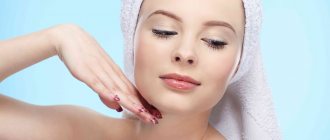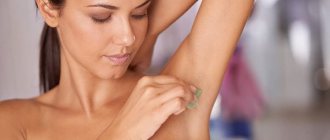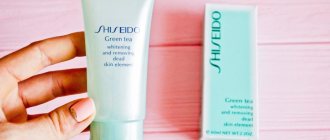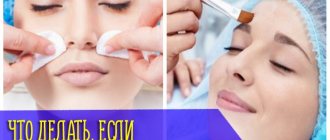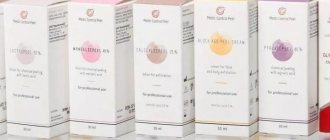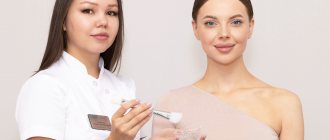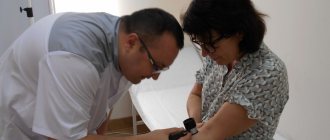From this article you will learn:
- Why peeling in summer can harm your skin
- Who is peeling recommended for in summer?
- What are the contraindications for peeling procedures in summer?
- What types of home and professional hardware peeling can be done in the summer?
- How to care for your skin after peeling in summer
Velvet and silky skin is the dream of every woman. Representatives of the fair sex often use a common cosmetic procedure - peeling. It renews the skin, the body begins to breathe, the dermis is transformed. After the manipulation, you can get an even complexion, lightening of age spots, cleansing and narrowing of pores. To avoid losing the effect, repeat cleaning regularly. Is it possible to do peeling in the summer and what the consequences of this procedure may be, you will find out in this article.
Self-healing of the skin is the secret.
Exfoliation is one of the most popular procedures for a very simple reason. Its high effectiveness is based on the natural mechanism of epidermis rejuvenation, when old layers are replaced by new elastic and elastic cells.
Not many organs in our body can heal themselves, the skin is one of them. This unique ability is used when exfoliating.
The secret to the effectiveness of exfoliation is the natural ability of the epidermis to renew itself.
Update mechanism. In the basal layer of the epidermis, this is the lowest layer of the five components of the epidermis, keratinocides are formed. During their life, they move upward. Along their life path, from the basal layer to the stratum corneum, keratinocides change. Gradually, life leaves them and in the stratum corneum they are already dead corneocytes, the connections between them are destroyed and natural exfoliation occurs.
Old cells of the epidermis, like dried out, last year's foliage, gray and earthy. The allegory is more true for aging, aging skin.
Superficial peeling comes down to speeding up the natural exfoliation process by removing keratinized cells, the same keratinocides in youth that turned into corneocytes in the stratum corneum.
The only way we help this natural function is to remove dead skin cells during superficial exfoliation, without waiting for their natural exfoliation. Mother Nature does the rest. Instead of deleted ones, qualitatively new ones appear.
- Peeling starts the rejuvenation process.
- The destroyed upper stratum corneum “gives a signal” to the lowest, basal layer - it’s time to act, it’s time to renew itself.
The mechanism is described in a simplified manner, many details are missing. The description is given only to understand what underlies exfoliation and why it works. You can read more about the structure of the epidermis in the article - Structure of the skin, epidermis.
This article will not discuss hardware methods of exfoliation that are used in beauty salons and medical centers. The article discusses home methods of peeling for the summer season.
Having excluded hardware methods from consideration, we will focus our attention on chemical and mechanical exfoliation.
What skin problems that arise in summer can peeling help cope with?
Pigment spots are the most common problem that occurs in summer. Peeling with fruit acids will help lighten blemishes, reduce the intensity of freckles and even out skin tone. But remember that aggressive cleansing and improper post-peeling care can, on the contrary, cause severe pigmentation. A well-done procedure promotes an even tan.
In the summer, the sebaceous glands work more actively, the skin becomes oily, and the pores become clogged. Peeling helps cleanse the skin of blackheads and acne, tighten pores, even out the texture and normalize the functioning of the sebaceous glands.
Depth of impact – safety and effectiveness.
Before talking about the types of exfoliation, it is necessary to understand the depth of impact at which peeling is carried out. To do this, let's get acquainted with the structure of the epidermis. This will help you understand how peels differ in depth of impact and risk of side effects.
There are only 5 layers in the epidermis, all of them differ in the vital activity of cells and their functionality. Cells become less vitally active from the lowest basal to the highest horny.
The topmost layer is the stratum corneum. Consists of keratinized particles and dead cells. The second one from the top is shiny. Well developed on the soles and palms, the cells are not as dead as in the stratum corneum, but not alive compared to the next layer. The next one is grainy. In structure and composition of cells, it differs from the shiny and horny ones. The main function is to create a protective barrier. Next, prickly. Here the conversion of keratinocides into corneocytes begins, and lipid synthesis also begins. And finally, basal. In this layer, the generation of cells occurs, which at the end of their journey will turn into keratinized particles.
Types of peelings by depth.
Superficial - affects only the stratum corneum. This type is used in the summer; we’ll talk about it in more detail a little later. The most delicate, but also less effective.
Median - works with living epidermal cells that are deeper than the horny one, but does not affect the basal one. The impact is deeper, the effectiveness of use and the possible risks of side effects are higher.
They are used as active chemical components.
- Trichloroacetic acid.
- Salicylic acid in high concentration.
- Azelaic acid.
- Retinol.
Deep – works throughout the entire depth of the epidermis of the barrier. High efficiency with relatively high risks of complications. This type is given in medical centers.
Phenol is used for deep chemical peeling.
What are enriched peelings?
These are modern atraumatic peelings, which contain active ingredients that work on skin problems.
Classic peelings are effective due to exfoliation and traumatization of the skin - the more peeling, the more pronounced the result.
What is the difference between enriched peelings?
- A low percentage of acids that work on the principle of enhancers - conductors for active ingredients;
- Active ingredients that work on skin problems: Peptides
- Plant stem cells
- Antioxidants
- Lightening Ingredients
- Sebum-regulating ingredients, etc.
Benefits of enriched peels
What are the advantages of enriched peels compared to other chemical peels:
- Atraumatic - do not provoke redness, peeling and irritation of the skin;
- Allows you to maintain full social activity;
- High efficiency – comparable to medium peels with heavy peeling;
- Possibility of individual selection according to skin type and problem;
The dark side of exfoliation.
Exfoliation is a controlled injury. The skin becomes vulnerable to external influences, especially to ultraviolet radiation, which is most active in summer. The deeper we act, the more defenseless the skin. Therefore, the question arises whether or not to do summer facial peels when the sun is at its maximum.
If you exfoliate incorrectly, you can get even more pigmentation or other complications instead of correcting age spots.
Deep peelings are strictly not recommended in the summer; medium peels are not recommended (some sources suggest the possibility of carrying out these procedures in the summer). Superficial is possible, but under certain conditions.
Let's summarize. Of the peels used in summer, without the risk of side effects, only superficial peels can be used.
The main problem of summer peelings is solar activity.
Acid peels in summer – is it really safe?
The fact that acid peels should not be done in the summer is written on almost every corner. This is due to the fact that most of them have a deep exfoliating effect, due to which the skin loses its natural protection and easily burns in the sun. There is also an increased risk of collagen damage, wrinkles and unsightly age spots.
However, this does not mean that you should give up all acid peels in the summer. There are many safe substances that gently exfoliate the skin and do not have a photosensitizing effect. Moreover, they prevent the accumulation of color pigments in the skin, thereby minimizing the risk of color deterioration. Other benefits of using acids in summer include smoothing, hydration and deep nourishment of the skin.
Moisturizing and deeply nourishing the skin in summer
Summer facial peels are not scary if you know which ones.
In summer, it is possible to carry out only superficial cleansing, using.
- Peels with fruit acids (AHA).
- Enzyme peelings.
- Scrubs.
Characteristics of summer exfoliation.
- The composition includes fruit acids with small molecules and unable to penetrate deeply.
- They have a “soft” effect.
- Acid concentration no more than 10%.
- Application does not cause sensitivity to the sun.
- To obtain results, a course of several procedures is required.
- The impact of summer peels is limited to the stratum corneum and no deeper.
Conventionally, they are classified as summer acids.
- Almond.
- Dairy.
- Wine.
- Lemon.
- Apple.
No matter how delicate the effect of summer peeling is, it is inherently traumatic. Therefore, it is important to understand both contraindications to the procedure and the need for post-peel care.
Contraindications to the use of peelings.
- The presence of injured areas, wounds, cuts, etc., as well as the presence of active inflammation.
- Cuperosis depends on the degree. Sometimes peeling is recommended, but not in the summer and a consultation is required.
- Recent procedures involving disruption of the skin (invasive).
- Acute skin diseases, allergic diseases.
- Having a recent tan.
- Taking medications that weaken the immune system or increase sensitivity to solar radiation.
Let's summarize. In summer, you can use exfoliation based on fruit acids of a certain concentration. But that is not all.
Peeling is not a summer procedure? What kind of peeling can be done in summer?
Peeling (from English to peel - peel off, exfoliate) implies thinning of the protective layer of the skin, which provokes increased sensitivity to ultraviolet radiation and the development of hyperpigmentation. The skin becomes more susceptible to the destructive effects of ultraviolet radiation and the cells that produce melanin are activated.
But cosmetology does not stand still, and if recently the answer to the question “is it possible to do peeling in the summer” was clearly negative, now experts say that peeling can be done in the summer.
There are not many types of such procedures: in summer you can use only superficial treatment options, which exfoliate only a couple of layers of the upper stratum corneum, working at the level of the epidermis.
In this article we will tell you more about the all-season peeling BioRePeelCl3. BioRePeelCl3 is an innovative patented two-phase peeling method that allows you to achieve a lifting effect, improve skin tone and eliminate age spots. It contains: trichloroacetic acid, tartaric acid, citric acid, salicylic acid, lactobionic acid, gamma-aminobutyric acid, arginine, proline, isoproline, sodium ascorbate, riboflavin. The uniqueness of this peeling can be described in three words - biorevitalization without injections. The Italian manufacturer INNOVATION has created an innovative peeling formula for our skin “3 in 1”: Revitalization + biostimulation + exfoliating effect Another feature is that this product is two-phase. Before application to the skin, two phases (lipophilic and hydrophilic) are mixed and work simultaneously, enhancing each other’s effect: - The hydrophilic phase includes acids, vitamins, and lifting components, which determine the launch of processes that improve the condition of the skin and rejuvenate it. - The lipophilic phase - active components responsible for moisturizing the skin and restoring the hydrolipid barrier - ensures the deepest penetration of stimulating components and restores the protective properties of the skin. That is, we get hydration, renewal (without injection) and exfoliation. The combination of these active components allows you to effectively combat skin aging, the effects of exposure to ultraviolet radiation and pigmentation, and the manifestations of acne. For what skin problems is BioRePeelCl3 recommended? Biorepil is considered a universal peeling, since the procedure helps to cope with a number of difficulties: dryness and dehydration of the skin; acne and post-acne, even if the rash is in the acute stage; age-related skin aging; pigmentation; shallow expression wrinkles; enlarged pores and overly oily skin. ⠀ Are there any contraindications for this procedure? In general, the manipulation is considered safe, but, like other procedures, there are cases in which BioRePeelCl3 peeling is not recommended: oncology; during pregnancy and lactation; individual intolerance to the components of the peeling composition; untreated herpetic infection; during the disease in the period of exacerbation and general inflammation of the body. What are the benefits? Suitable for all ages Peeling is aimed at solving various problems that are relevant for both adolescence and adulthood. No side effects There are practically no side effects. It is worth noting only the pinkishness of the skin, a slight tingling sensation, and the tightness of the skin for the first few minutes. When a qualified cosmetologist works and the patient provides complete information about the state of his health, serious side effects definitely will not appear. Short rehabilitation The procedure is not considered traumatic. Microscopic traces of the intervention may remain on the skin for 2-7 days, which will quickly disappear. No special care is required to restore the skin. But for several weeks afterwards, the skin may be hypersensitive to the sun's rays, so during this period it is worth using a cream with SPF protection. Also, after the procedure there is no redness, peeling, or “frost” effect; Takes a minimum of time and gives instant results; Year-round use. The drug used works in two directions at once - abrasive, providing delicate exfoliation of dead cells, and biorevitalizing - normalizing the internal processes of the skin and promoting overall rejuvenation. Now you know that you shouldn’t postpone your favorite peeling procedure that is necessary for your skin until the fall! In addition to BioRePeelCl3, there are several other types of “summer” peels, but only a doctor should decide whether a specific peel can be done for you. He will assess the need for this procedure, the condition and individual characteristics of your skin and the risk of age spots. The basic rule is that peeling in summer should take place only at the level of the stratum corneum without damaging the dermis. Although even after the most delicate composition, it is necessary to use sunscreen with the maximum level of protection and avoid exposure to direct sunlight.
What to do before and after peeling.
A prerequisite for any exfoliation is compliance with the relevant recommendations.
- Active exposure to sunlight should be avoided for 2 weeks before exfoliation.
- During the same 2 weeks, use washes with acids. This will allow the skin to adapt. The impact of washes is not so aggressive
- Do the procedure in the evening.
- After exfoliation, a neutralizer may be a good idea. This product contains alkali and soothing components that neutralizes the effects of acid.
- After peeling, apply SPF cream with a factor of at least 30.
- And also, use cosmetics - moisturizing, nourishing, restoring or soothing the skin. For example, an active mask. Instead of a mask, you can use a restorative or nourishing cream.
- Avoid direct sunlight.
Features of the recovery period after summer peeling
Summer is the peak of solar activity, the “burn boom.” Is it possible to peel in the summer if you don’t go out in the sun? It is unacceptable. The sun's rays are treacherous. During the healing period, the dermis becomes vulnerable. Prepare her especially carefully for the peeling procedure, and care for her carefully after completion. Start preliminary measures at least 10 days in advance and apply specialized cosmetics with high UV filters to your face. Serums that block melanin production will help you.
After the procedure, protect your skin from sunlight and use a product with a high level of protection (SPF 50) for at least two weeks. The more careful the post-peeling care, the faster you will get a renewed, radiant face.
Gentle peeling does not require special care after it has been carried out. But still, the rehabilitation period is not cancelled, it will last two weeks.
Follow these care instructions:
- It is forbidden to go outside in the first 12 hours after the procedure.
- During this time, you should not apply any cosmetics to your skin.
- In the first three days, wash with thermal water or foams and gels for sensitive skin.
- Avoid creams as they may reduce the peeling effect. Even if your product is hypoallergenic and intended for sensitive skin, do not use it.
- If cream is still necessary, consult a cosmetologist, he will suggest a suitable product.
- Do not use a scrub under any circumstances, it will only harm your skin.
- Forget about decorative cosmetics.
- Do not visit the sauna or solarium. If you are planning a trip to the sea, remember that swimming is prohibited. You are also not allowed to go to the pool.
- Monitor the balance of fluid in the body. Drink at least two liters of water per day.
Nowadays, you no longer have to spend a lot of time performing complex and unpleasant procedures at home. It is much easier to seek help from real professionals - the Veronika Herba beauty and health center, equipped with effective and modern equipment.
Why clients choose Veronika Herba Beauty and Health Center:
- This is a beauty center where you can take care of yourself at a reasonable cost, while your face and/or body will be treated not by an ordinary cosmetologist, but by one of the best dermatologists in Moscow. This is a completely different, higher level of service!
- You can receive qualified help at any time convenient for you. The beauty center is open from 9:00 to 21:00, seven days a week. The main thing is to agree with your doctor in advance on the date and time of your appointment.
Sign up for a consultation with a specialist by phone +7 (495) 085-15-13
, and you will see for yourself!
Enzyme peels are the best summer peels.
The principle of action of enzymes is the same as that of acids. They destroy the substances that hold the scales of the stratum corneum together. But the effects are so delicate that enzymes are used for sensitive types and for rosacea.
Main characters.
- Papaya extract.
- Pineapple extract.
General recommendations for the use of enzymes. From a physics course we know that the activity of substances increases with increasing temperature. Therefore, advice - after applying the composition to your face, wet your hands with warm water and massage for a few minutes, the activity of papaya and pineapple will be higher.
From theory to practice - Enzyme peelings from Cell Fusion, a well-known brand of professional skincare cosmetics.
Peeling for deep soft cleansing Gentle Deep Powder Wash Cell Fusion C, 70 gr. Basic care with an emphasis on deep cleansing. Provided with a unique composition of a patented complex of lipid barrier strengthening NEO-CMS and papaya enzymes, also contains fermented pollen extract, collagen and cactus extract.
Enzyme cleansing peeling Papaya Granule Peels, 50 gr. - a unique composition of: papaya enzymes, allantoin, corn starch and lactose provide an exfoliation effect and hydration.
Scrubs are all about the tiny bit.
Peeling and scrub differ in their active ingredients. In one, the working agents are acids or enzymes, in the other, abrasive particles are used. But they have only one object of influence, these are keratinized scales. Therefore, an alternative to summer exfoliation is a scrub. The abrasive particles of the scrub may be different. These can be natural or synthetic particles. Natural doesn't mean best. Synthetic beads exfoliate more gently and can be used even on dry or sensitive skin.
The key difference between synthetic particles is no longer an abrasive effect, but a delicate grinding that eliminates micro damage.
When comparing scrubs and peels, it's more a matter of personal preference. When using chemical exfoliation, the degree of irritation depends on the individual perception of acids, their type, and the degree of their concentration. Those. The number of factors and uncertainties that need to be considered when choosing a chemical exfoliator is greater compared to a scrub. On the other hand, acids have additional impact factors that scrubs do not have.
From theory to practice - Exfoliating products from Obagi ZO Skin Health, a well-known brand of professional skincare cosmetics.
Dual action scrub, 116 g. - a unique composition of: patented complexes, delicate scrubbing elements (synthetic wax, candelilla wax), AHA and BHA acids (salicylic and lactic).
When using scrubs, you must keep the following in mind. Do not use scrubs for irritated and inflamed skin, as well as for rosacea.
How to make safe summer peeling at home?
Superficial peeling is easy to do at home. Light acid or gommage is suitable for this.
The acidic product is applied to cleansed skin, left for a certain time and washed off with water.
It is better to use the scrub on steamed skin, apply with massaging movements and rinse.
Gommage is an ambrosial agent with acid, available in the form of a roll. Apply with massaging movements and roll into pellets, then rinse off.
Folk remedies that can be used for scrub: sugar, ground coffee, honey, semolina.
